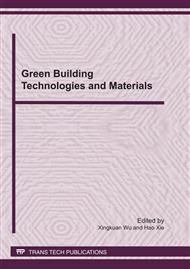[1]
O. Keski-Rahkonen: Breaking of window glass close to fire. Fire and Material Vol. 12, No. 2 (1988), pp.61-69.
DOI: 10.1002/fam.810120204
Google Scholar
[2]
G.M. Sottile: 2004 Survey of United States architects on the subject of switchable glazings. Materials Science and Engineering B Vol. 119, No. 3 (2005), pp.240-245.
DOI: 10.1016/j.mseb.2004.12.077
Google Scholar
[3]
K.A.R. Ismail and J.R. Henriquez: Parametric study on composite and PCM glass systems. Energy Conversion and Management Vol. 43, No. 7 (2002), pp.973-993.
DOI: 10.1016/s0196-8904(01)00083-8
Google Scholar
[4]
J. Benemann, O. Chehab and E. Schaar-Gabriel: Building-integrated PV modules. Solar Energy Materials & Solar Cells Vol. 67, No. 1-4 (2001), pp.345-354.
DOI: 10.1016/s0927-0248(00)00302-0
Google Scholar
[5]
R.E. Collins and T.M. Simko: Current status of the science and technology of vacuum glazing. Solar Energy Vol. 62, No. 3 (1998), pp.189-213.
DOI: 10.1016/s0038-092x(98)00007-3
Google Scholar
[6]
S. Chaiyapinunt, B. Phuakphongsuriya, K. Mongkornsaksit and N. Khomporn: Performance rating of glass windows and glass windows with films in aspect of thermal comfort and heat transmission. Energy and Buildings Vol. 37, No. 7 (2005), pp.725-738.
DOI: 10.1016/j.enbuild.2004.10.008
Google Scholar
[7]
G.F. Menzies and J.R. Wherrett: Windows in the workplace: examining issues of environmental sustainability and occupant comfort in the selection of multi-glazed windows. Energy and Buildings Vol. 37, No. 6 (2005), pp.623-630.
DOI: 10.1016/j.enbuild.2004.09.012
Google Scholar
[8]
S. Citherlet, F.D. Guglielmo and J.B. Gay: Window and advanced glazing systems life cycle assessment. Energy and Buildings Vol. 32, No. 3 (2000), pp.225-234.
DOI: 10.1016/s0378-7788(98)00073-5
Google Scholar
[9]
T.L. Saaty, The Analytic Hierarchy Process. New York: McGraw-Hill, (1980).
Google Scholar
[10]
O.S. Vaidya and S. Kumar: Analytic hierarchy process: an overview of applications. European Journal of Operational Research Vol. 169, No. 1 (2006), pp.1-29.
DOI: 10.1016/j.ejor.2004.04.028
Google Scholar
[11]
M. Bertolini, M. Braglia and G. Carmignani: Application of the AHP methodology in making a proposal for a public work contract. International Journal of Project Management Vol. 24, No. 5 (2006), pp.422-430.
DOI: 10.1016/j.ijproman.2006.01.005
Google Scholar
[12]
X. Zhu and A.P. Dale: JavaAHP: a web-based decision analysis tool for natural resource and environmental management. Environmental Modelling & Software Vol. 16, No. 3 (2001), pp.251-262.
DOI: 10.1016/s1364-8152(00)00082-7
Google Scholar
[13]
M.K. Tiwari and R. Banerjee: A decision support system for the selection of a casting process using analytic hierarchy process. Production Planning & Control Vol. 12, No. 7 (2001), pp.689-694.
DOI: 10.1080/09537280010016783
Google Scholar
[14]
E. Karami: Appropriateness of farmers' adoption of irrigation methods: the application of the AHP model. Agricultural Systems Vol. 87, No. 1 (2006), pp.101-119.
DOI: 10.1016/j.agsy.2005.01.001
Google Scholar
[15]
J.K.W. Wong and H. Li: Application of the analytic hierarchy process (AHP) in multi-criteria analysis of the selection of intelligent building systems. Building and Environment Vol. 43, No. 1(2008): 108-125.
DOI: 10.1016/j.buildenv.2006.11.019
Google Scholar
[16]
K.F. Chang, C.M. Chiang and P.C. Chou: Adapting aspects of GBTool 2005 – searching for suitability in Taiwan, Building and Environment Vol. 42, No. 1 (2007), pp.310-316.
DOI: 10.1016/j.buildenv.2005.08.015
Google Scholar
[17]
C.M. Chiang and C.M. Lai: A study on the comprehensive indicator of indoor environment assessment for occupants' health in Taiwan. Building and Environment Vol. 37, No. 4 (2002), pp.387-392.
DOI: 10.1016/s0360-1323(01)00034-8
Google Scholar


